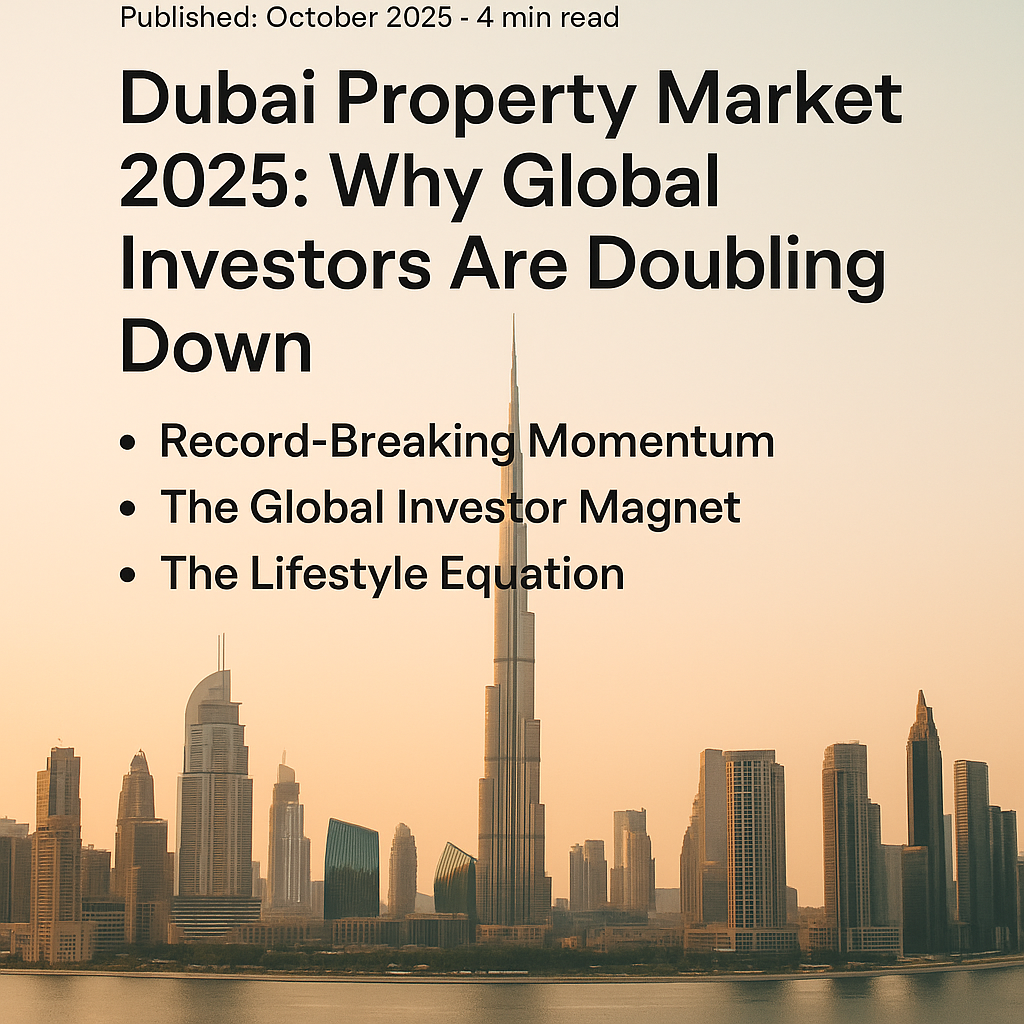The real estate sector in Dubai is riding a feverish wave, and one of the hottest stories right now is the explosive surge in apartment and off-plan property sales.
1. Market Snapshot: Numbers That Speak Volumes
In the third quarter of 2025, Dubai recorded 59,228 property sales transactions valued at AED 170.7 billion — the highest quarterly figure ever.
• Apartment sales dominated: in Q3, apartment deals reached a value of about AED 93 billion (≈ US $25.3 billion) with volumes climbing ~22% year-on-year.
• Off-plan transactions are now making up around 70% of all sales volumes in certain quarters.
• Meanwhile, villa transactions are cooling relative to apartments.
Putting this together — buyers are actively choosing apartments and pre-launch (off-plan) projects, pushing volumes and values to new highs.
2. Why Are Apartments & Off-Plan Properties Leading the Charge?
a) Affordability & Volume
Apartments — especially in emerging or suburban communities — typically offer lower entry prices compared to luxury villas. For many investors and end-users, the apartment segment becomes more accessible. Off-plan sales allow even more flexibility (e.g., staggered payment plans, early-bird pricing) which further attracts demand.
b) Strong Investor Sentiment
Dubai is increasingly seen as a stable and growth-oriented real estate market. Global investors continue to view it as a safe asset, especially with favourable policies (like residence-linked visa programs) and infrastructure expansion. This perception encourages them to lock in new launches early (off-plan) and accept “future delivery” for anticipated capital appreciation.
c) Supply & Timing Factors
Many developers are launching new apartment-centric projects, especially in suburban or fringe zones, which the market is absorbing. The villa segment, by contrast, faces greater supply constraints and higher price points, making it less nimble. Off-plan property allows developers to capture pre‐completion demand and enables buyers to buy in before hand-over and sometimes at lower effective cost.
d) Changing Lifestyle & End-User Demand
With more people relocating to Dubai, choosing longer-term residence rather than short-term stays, there is growing demand for homes that offer value, amenities, and deliverability. Apartments in newer communities, often with strong infrastructure and lifestyle facilities, check those boxes. Reports suggest end-users (not just pure investors) are playing a growing role.
e) Regulatory & Policy Supports
The market environment is benefiting from policies that support foreign investment, streamline property transaction processes, and broaden access to off-plan investment. All this enhances confidence.
3. Considerations & Risks to Watch
While the trend is strong, it’s not devoid of cautions:
• Supply risk: A pipeline of new apartments may flood the market in the next 1-2 years, which could dampen price growth or rental yields in some segments.
• Segment differentiation: Not all off-plan projects or apartment locations will perform equally. Quality, location, developer reputation and hand-over timelines matter. Buyers should exercise due diligence.
• Price escalation & affordability: Rapid upswing in values could price some buyers out or reduce yield potential (if rents don’t keep pace).
• Market cycle: Every boom has its phases. While Dubai’s fundamentals appear robust, external macroeconomic shocks, interest-rate changes, or regulatory shifts could create headwinds.
4. What This Means for Different Participants
• For investors: Apartments in high-growth zones sold off-plan may offer strong capital-growth potential, especially if bought early in the launch. But appetite for risk should be measured — choose reliable developers, understand payment plans, and consider exit/hand-over timelines.
• For end-users/home-buyers: Apartment life may offer a more affordable entry into Dubai’s real estate market, access to newer communities and lifestyle amenities. But check delivery risks, service-charges, community plans and future rental/maintenance costs.
• For developers: The focus is shifting toward smart, well-amenitised apartment projects, perhaps in emerging zones rather than just ultra-luxury villas. Flexibility in payment schedules, off-plan marketing appeal, and strong localisation (amenities, sustainability, connectivity) are key.
• For policy-makers/regulators: Ensuring that supply doesn’t outpace demand excessively, maintaining transparency in off-plan transactions, and addressing infrastructure/amenity delivery will be important to maintain market health.
5. Outlook: What to Expect in the Near Future
Based on current data and expert commentary:
• Apartment values and off-plan sales are likely to remain elevated in 2025 due to momentum and international demand.
• Growth may become more selective: premium locations/brands will outperform generic projects; price growth may moderate rather than accelerate endlessly.
• Supportive infrastructure expansions (metro, airport, connectivity) will continue to bolster suburban and fringe communities, shifting some investor focus away from traditional hotspots.
• Rental yields and occupancy may remain healthy but pressure may build in areas with heavy new supply; so attention to yield (not just capital growth) is wise.
• A modest correction or stabilisation phase might emerge in 2026-27 if supply surges and macro-economic headwinds increase.
6. Key Takeaways for You
If you are considering buying in Dubai, the apartment/off-plan segment is worth serious consideration given current market dynamics.
• Always analyse: location & community, developer track record, hand-over date & payment plan, future supply in the area, local rental market (if investing) and exit strategy.
• Don’t assume all apartments or off-plans will behave the same — there is still differentiation in risk and reward.
• Keep an eye on the broader real estate cycle: strong markets are great, but timing matters.
• Consider your objective: Are you buying for rental income, capital appreciation, lifestyle, or residency? Your strategy should align.


